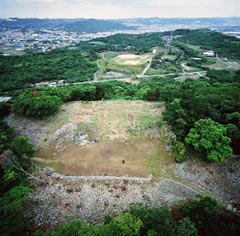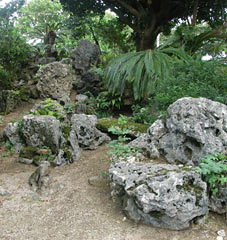Cultural Affairs Council recommends two Okinawan sites to Minister of MEXT

Shimashii-Ozato Castle Ruins have been selected as an officially designated historical site at Ozato in Nanjo City.
November 19, 2011 Ryukyu Shimpo
On November 18, the Cultural Affairs Council (headed by Suzuko Nishihara) asked Masaharu Nakagawa, the Minister of Education, Culture, Sports, Science and Technology (MEXT)
to designate the Shimashii-Ozato Castle Ruins of Ozato in Nanjo as an officially-designated historical site, and register the Nakamoto Garden of Ishigaki on Ishigaki Island as a national registered monument (sightseeing spot), at a separate meeting of the Council regarding cultural property. These will be the 36th officially designated historical site and the second registered monument in Okinawa Prefecture.
Shimashii-Ozato Castle Ruins is a gusuku (castle) that prospered as a residence of King Sannan in the Sanzan period (around the 14th to the 15th century). It is built of Ryukyu limestone on a hilly area, 150 meters (almost 500 feet) above sea level, and skillfully utilizes the natural contours ground. Inside the main building there is a place for worship, a well and a tomb of the Aji, who were the people in the ruling class at the time. The castle is highly valued both historically and academically because of its importance in assessing the process from the instability of the Sanzan period to the establishment of the Ryukyu Kingdom.

Nakamoto Garden at Ishigaki on Ishigaki Island has been registered as a national registered monument.
Nakamoto Garden, located in the grounds of a house in Yaeyama of the high warrior class under the administration of the Ryukyu Kingdom, is estimated to have been constructed in the middle of the 19th century. Constructed mainly from Ryukyu limestone and of the dry garden style, it is a valuable example of the spread of Japanese garden culture to Yaeyama.
(English Translation by T&CT, Lima Tokumori and Mark Ealey)
Previous Article:Event in held Shanghai to promote the second anniversary of the Okinawa International Air Logistics Hub Project
Next Article:Government to pay the total cost of evacuation in cases of unexploded ordnance disposal operations
[Similar Articles]
- Early 14th century castle wall discovered at Nakagusuku Castle, predating previously accepted historical timelines
- Shiraho-Saonetabaru Cave Ruins, where 27-thousand-year-old human remains were found, to be designated a national Historic Site
- Ancient Roman and Ottoman copper coins unearthed for the first time in Japan at Katsuren Castle, possibly from maritime trade
- Looking back on Shuri Castle, world heritage site: 450 years of Okinawan politics and culture
- World Heritage site Nakijin Castle wall collapses due to Typhoon Number Seven
 Webcam(Kokusai Street)
Webcam(Kokusai Street)


